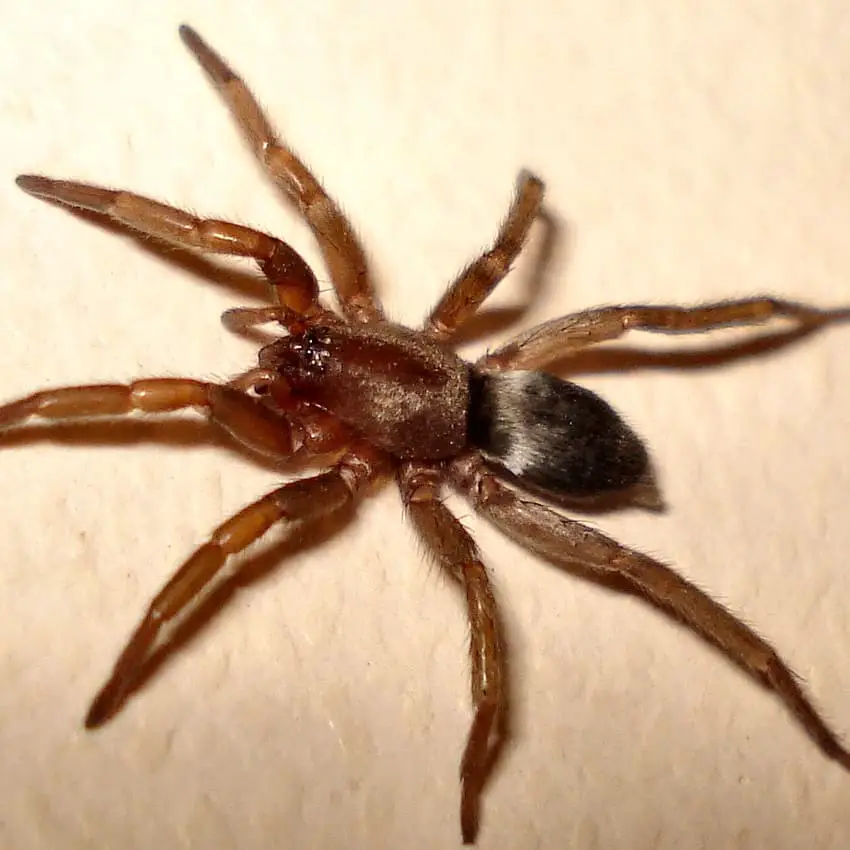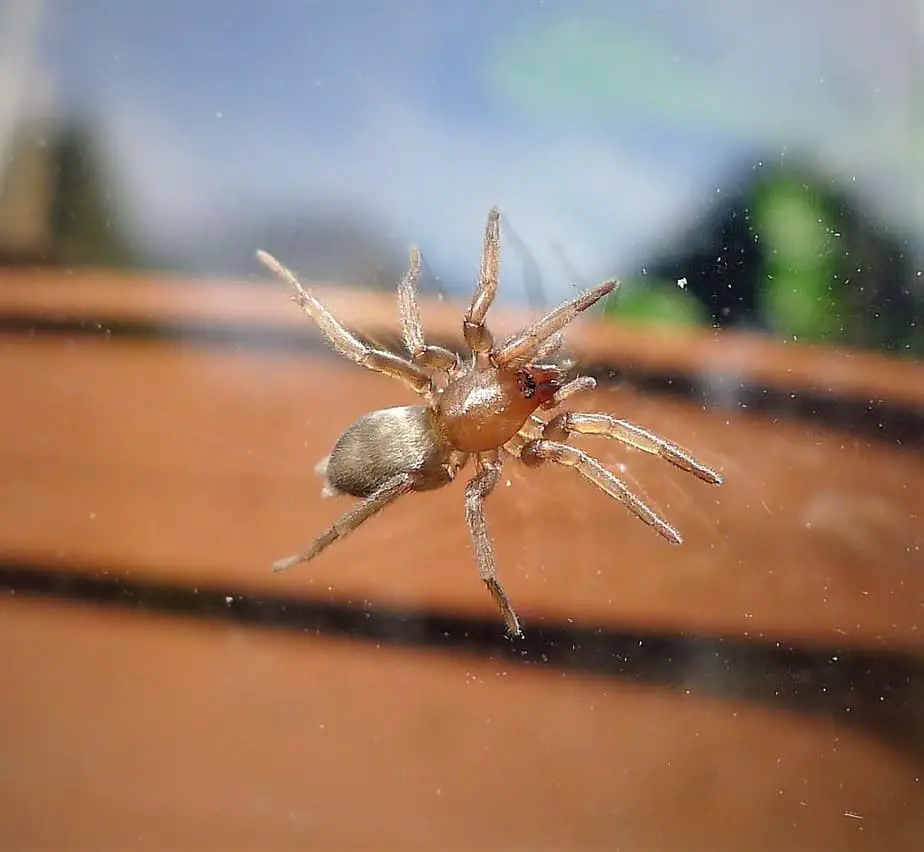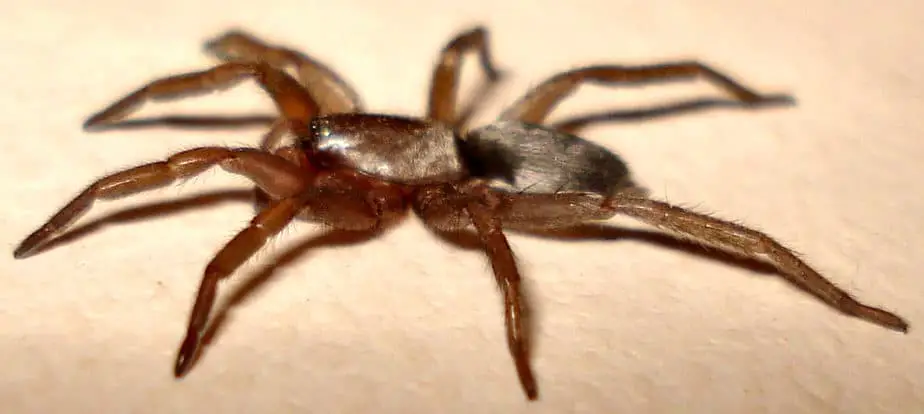Scotophaeus blackwalli, the mouse spider is a ground spider that is common in Central and Northern Europe and the Western United States. The spider is not of medical significance and should not be confused with the venomous mouse spiders found in Australia of the genus Missulena.
Description of the mouse spider

The mouse spider is part of the Gnaphosidae ground spider family. Its abdomen is mostly gray and velvety like the fur of a mouse. The cephalothorax (head) of the spider and the legs are usually in a lighter color, either brown or gray. The body of the spider can sometimes appear shiny even though it is covered with small hairs.
Aside from their velvety gray abdomen, that reminds of a mouse, the mouse spider also has a very peculiar way to move. It can move very quickly but often stops abruptly for a short period of time and then continues the movement. This resembles the movement of mice and might have also led to the spiders common name.

The spiders is sometimes confused with the broad-faced sac spider (Trachelas tranquillus) or the woodlouse hunter (Dysdera crocata). In California, the spider can be confused with the female Metaltella simoni hacklemash weaver. The mouse spider can best be distinguished by the velvety gray abdomen and the fact that its body is almost touching the ground when moving and appears lower than the legs.

Size
Scotophaeus blackwalli is a medium-sized spider. Females reach a body size of up to 0.5 in. (12 mm) while males are slightly smaller. They reach a body size of up to 0.35 in. (9 mm).
Web
Ground spiders are hunting spiders that don’t spin webs to catch their prey. They roam around at night looking for small insects they can prey on. Mouse spiders also feed on dead insects and other spiders. They produce gluey silk with their relatively large spinnerets which the use to immobilize and subdue their prey. Thanks to this feature, they are able to prey on relatively large prey animals, including other, larger spiders.
Mouse spiders spin web-like structures to lay their eggs on which are then covered with more silk to protect the offspring. These web-like formations are often found inside homes in the Western United States
Bites
The mouse spider Scotophaeus blackwalli does not pose any danger for humans or larger pets. Its venom is relatively weak and the spider uses its gluey silk to subdue its prey. This species of mouse spider occurs in Europe and the Western United States and should not be confused with the black mouse spiders of the genus Missulena that occur on Australia and Chile. These Australian and South American spiders are known to cause some bites of medical significance.
Distribution of the Mouse Spider in the USA
In addition to their natural range throughout Europe, the Scotophaeus mouse spider has been introduced to the Western United States and has established sizeable populations in California, Oregon and Washington. Occasionally, the spider is also seen in Nevada, Idaho, Utah, Wyoming, Colorado, Montana and Arizona.
Scientific Classification of Scotophaeus blackwalli
- Kingdom: Animalia
- Phylum: Arthropoda
- Subphylum: Chelicerata
- Class: Arachnida
- Order: Araneae
- Infraorder: Araneomorphae
- Family: Gnaphosidae
- Genus: Scotophaeus
- Species: Scotophaeus blackwalli
Other common names:
The mouse spider Scotophaeus blackwalli is commonly also called (stealthy) ground spider.
References:
- Taxon details: World Spider Catalogue
- Binomial name from: Thorell, 1871
- https://spiderid.com/spider/gnaphosidae/scotophaeus/blackwalli/

Hello Linda, thanks for getting in touch. No, this is not a rabbit hutch spider. This is some species of ground spider (Gnaphosidae). Given your location, it could be a gravid female mouse spider( Scotophaeus blackwalli): https://usaspiders.com/scotophaeus-blackwalli-mouse-spider/
Found on the ceiling in Vancouver, WA.
Hello Tim, thanks for uploading this image! This is definitely some type of ground spider of the family Gnaphosidae. It’s hard to make an ID on species level but it could be a mouse spider (Scotophaeus blackwalli): https://usaspiders.com/scotophaeus-blackwalli-mouse-spider/
I could not get a good picture because I am terrified of spiders but I feel pretty confident that this is also a mouse spider. Found on a wall in my basement in Portland Oregon.
Should I let him stay inside or would he be healthier outside?
Hi Debra, thanks for getting in touch! Assuming you are somewhere in the U.S., outside temperatures should be fine for it at the moment. So it can safely be relocated outside with a piece of paper and a jar/glass.
Found her walking around the garbage can, eating flies? Very slow, beautiful shiny jet black with joint white rings and a fury abdomen with two little bumps on the tail. Portland, Oregon August 29th 2021
Is this a mouse spider? Found it on top of my logs.
Was walking my dog at our nearby park in Redmond, WA, and spotted this large spider on the side of a 200’ tall, nearly 4’ in diameter fir tree. I spotted him at night with a headlamp on from about 10’ away. His body was about the size of a nickel, and his legs out, was about a 1/3” larger than a quarter. I have never seen a spider this color, that large in this area. I’ve lived here 40+ years. It’s a reddish brown/gray color. Couldn’t find any pictures on any of the Washington spider sites that came close.. Hoping to find out what he is. He was about 6’ up the tree, just hanging out. No web in sight.
Hello David, thanks for getting in touch! This is most likely a mouse spider (Scotophaeus blackwalli): https://usaspiders.com/scotophaeus-blackwalli-mouse-spider/
It’s not a medically significant spider.
Tumwater Washington
Hello Steven, thanks for sharing this find. This is not a mouse spider, this is some type of mygalomorph spider. It’s most likely a folding-door spider in the genus Antrodiaetus. They are quite common in Washington at this time of the year. Here is more information about them on bugguide: https://bugguide.net/node/view/23442
Hi sorry for this late reply. Might this be a Callobius sp.? I lived in Redmond for twenty years and never saw one, but we have moved to the Olympic Peninsula and Callobius Severus are very common. Now it seems I see more and more reports of them being in East King County. If this is a Callobius, it seems that their population is increasing. Just a thought.
Wondering what this spider is called and is it male or female?
Found this spider in the basement. Conifer, Colorado. Pretty small but quick!
Hello Ashley, this is some type of ground spider (Family Gnaphosidae). It’s most likely a mouse spider (Scotophaeus blackwalli): https://usaspiders.com/scotophaeus-blackwalli-mouse-spider/
I found this spider in my bathroom. I live in SE Iowa. Can you identify it for me?
I found this spider in my house in Seattle. The body is about 1/2 inch or more. The issue is that over the past few months I think I’ve been bitten by a spider. The spots itch for months and have two red dots about a 1/4. My dermatologist says they’re aren’t bites. I’m not so sure. Could this be the culprit
Hi David, I can’t comment on the bites. But this is a mouse spider (Scotophaeus blackwalli): https://usaspiders.com/scotophaeus-blackwalli-mouse-spider/
This is not a spider that would cause any medically significant bites. But any insect bite wound can get infected. However, a dermatologist should know – so it’s most likely something else. Spider bites on humans are quite rare.
This spider does bite & has been biting me on my calf area of my leg’s every couple of days while I sit on my couch! I wasn’t sure of the location I was getting bitten. To my delight he came out to bite me this morning, I guess I didn’t give much much chance last night. Out corner of my I saw him run across then down under the lip of cushion. I jumped of the couch & down to that level & waited. Then started to move where would be & I hit him with flip flop. Definitely a mouse spider & the bites have been very itchy & red. With cortisone cream etc.. take about five day’s to go away. I’m over the moon I got him, cause if he got away I don’t think I would have been able to sit still. I was bitten 5 time’s in the last ten day’s!! THEY BITE PEOPLE (Portland OR)
Found this in my bathtub early this morning! I guess they are pretty common, first one I’ve found in my home though.
John
Is this a Scotophaeus blackwalli? Ive found 3 in my home in Arizona. Should i be worried?
Found this guy running across my carpeted bedroom floor at night. Noticed it out of the corner of my eye with only some lamp light on. It’s June/summertime here in Southwestern Ontario, Canada. I have never seen a spider like this before!
This one walked up the wall right beside me! Not expecting a mouse spider in Texas (if that’s what it is)
I live in southeast Arkansas, and had never seen mouse spiders before, however I think that I have seen three in about a weeks time. Not sure how it would have gotten here, I live in a rural area on a mountain. Not sure if someone should be notified!? Is this a mouse spider?